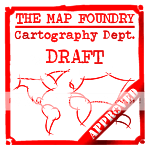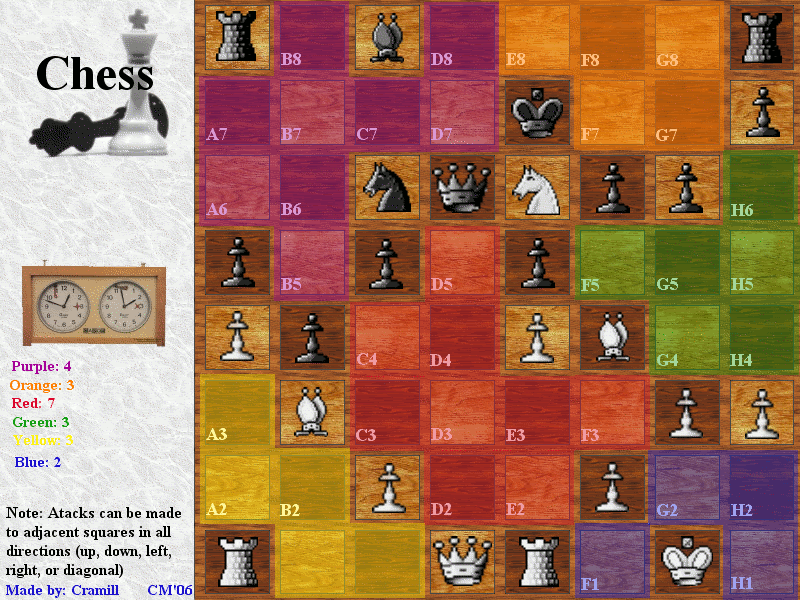




Map Name:KNIGHTS
Mapmaker(s):Koontz1973
Number of Territories:64
Special Features:Strategy over luck.
What Makes This Map Worthy of Being Made:Completely original and completely balanced for 1v1 games.
Map Image:


xml
http://www.fileden.com/files/2012/1/27/3255536/KNIGHTS.xml
- show: christmas skin maps
- Click image to enlarge.


- show: Halloween skins
- Click image to enlarge.


- show: images with 88s
- If are wondering about the white 88's it is because the xml will be easier to write this way in the xml tool.

http://img440.imageshack.us/img440/807/nklxml.png
http://img808.imageshack.us/img808/4551/nksxml.png
Gameplay notes.
Only 2 positions will be programmed into the xml. In 2 player games both will receive 16 territs at the opposite ends of the board. All 32 territs in the middle will be programmed with 1 neutral, no degrading or killer. As stated in the game board, no continents, no normal reinforcements, only 5 troops per round (no matter how many territs you hold) and spoils (if in play).
All other games will have random drops at both ends. The middle will always be neutral. If it becomes available in later updates the xml, this will be done.
3 player games - 10 territs - drop of 5 (2 extra neutrals)
4 player games - 8 territs - drop of 5 (0 extra neutrals)
5 player games - 6 territs - drop of 5 (2 extra neutrals)
6 player games - 5 territs - drop of 5 (2 extra neutrals)
7 player games - 4 territs - drop of 5 (4 extra neutrals)
8 player games - 4 territs - drop of 5 (no extra neutrals)
The extra neutrals will be programmed as 3.
Why this.
A chess map has been tried many times before but without a major update to the xml, this will never come about as all pieces move in different ways. So instead of trying for a normal map set on a chess board, the best solution I feel is to have one type of piece and make all pieces the same. This makes for the most balanced drop in 1v1 games ever. Will be great for all game types. Also thehippo8article in the Dispatch a couple of issues ago got me thinking.
Here is the original articles that got me thinking.
thehippo8 wrote:
- show
- Strategy games attract people of a similar mind. So, it comes as no surprise that on Conquer Club there are a fair swag of budding chess aficionados. And like any sub-set on Conquer Club they yearn for representation by way of a map. In the words of Hopscotcher ...
and i'm just really really curious, why is there no chess map on CC?.
In this quick overview, I will look at five examples which were all promising but as at this date still remain undeveloped.
cramill's chess map
This map is an impressionist view of chess which is evocative of a feeling of looking at the chessboard but retains the Conquer Club classic map concept. It’s appeal is that on the one hand chess players feel at home wistfully looking at a board while non-chess players can get down to brass tacks in conquering land.
- Click image to enlarge.
Over seven pages, the log makes for interesting reading. The map itself started as a crude box and letters concept to the colourful worked version it is now. There was discussion on piece placement to make the static game appear more believable. Clever gamesters worked on gameplay, region bonuses and territory boundaries. There was more than a fair share of nay-sayers and some very committed supporters. But ultimately this map is in limbo because of the mapmakers personal commitments. Final post was Thu Jun 07, 2007 4:39 pm.
fumandomuerte's C.C Chess V.2
This cartographer nodded to cramill before suggesting what at first glance was a very different look, feel and idea.
[BigImg]
http://img253.imageshack.us/img253/5035 ... lv2yh5.png[/BigImg]
Although just three pages, the log was very encouraging. The gameplay was more complex and advanced than cramill’s idea and that caused a little bit of confusion until fumandomuerte made an amendment to the map. There was some collaborative talk but the steam ran out of the thread and it was placed in the back room. Final comment on Fri Apr 18, 2008 6:43 pm.
john9blue's Chess
Placing this third is no reflection of its date of inception or its popularity. john9blue's map is acknowledged and even mentioned in fumandomuerte’s thread and towards the end of that thread there is talk of collaboration. Even camill goes so far as to pledge his support. And deservedly so.
- Click image to enlarge.
At a whopping 21 pages, there was truly an intense interest in this map. And the commitment of john9blue is nothing short of extraordinary. Although, the concepts were developed by remarkably talented thinkers who deserve recognition like Keredrex, turtle32, oaktown, ZeakCytho and TaCktiX (to name a few). And for all that effort this map achieved these tags ...
Yet despite all that the map still remains in limbo. There is some amusing skiting about chess prowess 'over the board' and the thread goes dead multiple times, but steadily there was such great progress. The gameplay continued to harangue throughout and on page 21 of the thread MrBenn again raised whether it was clearly explained. The efforts to get the graphics just right are enough to cause hair-loss alone. Maybe john9blue just ran out of puff. Before the map was finally placed in the recycling bin, FlyingSquirrel brought back the territory idea already considered by cramill and fumandomuerte. But again, this has gone nowhere. Last post was on Sun May 23, 2010 12:48 am.
kroovi's Battlechess map
And now for something completely different.
- Click image to enlarge.
The log is short and full of angst. Ultimately this is an idea in development – technically brilliant but not yet appealing to the masses. Last post was on Sun Nov 08, 2009 6:27 am.
Timur the Lame's Star Trek 3D Chess
Ok, so this idea is really at it’s early stages. But any Trekkie would be truly starry-eyed at the prospect of that fantastic game coming to life ...
- Click image to enlarge.
There’s only seven posts on the one page log, but army of nobunaga and 00iCon suggested a merger of chess with the 3D Cube idea – which is sadly also in the recycle bin (despite its enormous 56 page thread). Wouldn’t that be a hoot if that idea was the one to actually take flight!
So which one wins?
It is not hard to be impressed by all these efforts. Only time and the will of the Conquer Club Community will tell which one wins. It has proven to be a time-consuming and difficult concept to bring about. But it is clear that there is both the interest and an astounding amount of good will behind this map idea. Who knows whether one of these ideas will finally make it to fruition. There are plenty of us who are keenly waiting. Don’t keep us waiting too long!
As to who I think the winning concept amongst these five, I personally like john9blue's idea. To me it is a well-worked clever realisation of the chess concept. Thankfully my opinion is shared by others, not least of which include camill and fumandomuerte. But the one that I really want to see developed is the 3D Chess concept. That seems to me a brilliant inter-mesh between the chess strategy game and the awesome cube idea. But then I guess I'm a dreamer.
- show
- Chess revisited: What is the essence of the game? by thehippo8
In case you are reading this and wonder if I am obsessed by chess, you’d be right. But no, I won’t write about chess for every article. But the last article did miss an important point (well truth be known OliverFA suggested an idea ... and, ok, I jumped at the notion) that there might be more to the mystery behind why the chess game hasn’t translated so well to this forum. Do the maps suggested capture the dynamics of chess? What is the essence of the chess game itself? How can this be meaningfully represented in this mode?
In answering these questions, we get to the fundamentals of the merger between the aesthetic and the functional. Such concepts have, I suggest, application to the development of any map and it is hoped that such an analysis may have applicability to any map development – not just chess – by analogy. Ok, so that’s a high flatulent way of saying – what’s good for one must be good for all.
So, in this article I will break it down to two bits. The first covers the essence of chess and the second covers modelling.
What is chess?
I make no bones about it, explaining the game of chess takes a bit of time and I make no apologies for that. Modern chess is a game played on a square board in turn divided into an eight by eight grid. Those squares are, for convenience and to aid in envisioning where the pieces go, alternately coloured. The grid is the extent of where the pieces can go, the sides forming natural barriers. Like any battle field, owning space is better than being cramped in the corner and the centre of the board is revered because that is the position of most space. The game is played by two players (or in another extrapolation two teams democratically deciding moves). Although it is a game it is in fact representative of two armies at war. Each of the chess pieces is representative of key dynamic entities typically found in battle. The ultimate objective is to checkmate the opponents king, but as the game develops there are mini-objectives of taking territory, taking pieces or placing your pieces in a better position from which attacks can be made.
There are the foot soldiers, or pawns. They have limited movement in that they can only move one square forward at a time, save if they have not moved and there is space then on the first move only they can move two squares. These soldiers don’t have guns, they have knives. They attack by stabbing diagonally to the left or right, but only to the immediately adjacent square, as in close fighting. The two square move was a modern effort to speed up the game, but in an effort to avoid sneakiness by an opponent if an opposing pawn has made it to the fifth rank the slowpoke pawn can’t escape by moving two squares – the advanced pawn can still stab the pawn as it passing (hence the term en passant). Aside from the two move thing, the pawn has remained throughout the history of chess this slow and seemingly insignificant piece. But insignificant it is not. A pawn, on reaching the eighth rank, can be promoted to any other piece (other than a king) which the player desires. Historically this promotion was to a much less powerful piece (the fers) which could only move diagonally one square at a time. Moreover, the pawns are like a movable barrier bristling with their knives from which the opponent’s pieces must beware. Also, the pawns block an army’s movement because an army cannot attack its own pieces. In a real game of chess, the placement and movement of pawns changes the nature of the whole game. Opening doors and closing them, directing the flow of the other pieces or just getting in the way! The placements of pawns create the structure of the game, provide names for different opening set-ups and are indeed the soul of the game. Such a lot from such a little piece!
The bishop moves on the diagonal of the coloured square on which it starts. Because of the checkerboard nature of the board and the placement of the bishops that means that each player has a dark squared bishop and a light squared bishop. Opposing bishops of the same type can attack each other but opposite squared bishops can happily stand next to each other in peace. After all the other pieces have gone, so there are just an equal number of pawns left, it is often said that opposite squared bishops would result in an even game or draw. But the bishops are powerful when co-ordinated with other pieces. They can move quickly through any diagonal (so long as your pawns or other pieces aren’t blocking the way!). Historically, this piece was more limited in power and was actually based on an elephant which could leap diagonally over any diagonally adjacent square whether over another piece or not so long as there is not another elephant there (modern chess is a derivative of an older Indian game Shatranj so representation of an elephant should come as no surprise).
The knight is the strangest piece for people new to chess to understand, and probably the one that is the most fun. There is something almost magical in the way that the knight can leap clean over one of your own pawns and head an attack on an opponent’s piece or position. The knight is, of course, a horse with a rider and the rider has attitude. Historically this piece has always moved like this. Knights can find themselves trapped if they don’t watch where they are going but equally because of their reach can in turn end the game by leaping over the opponent’s pieces which would protect the king but find themselves just getting in the way and trapping the poor king with no way out. Knights and bishops can be powerful and those two pieces with a king can actually checkmate the opponent.
The Rook is the strong siege tower which can be wheeled along the files and ranks of the board. It is truly powerful and, with a king, is all you need to finish off your opponent if the position is right. Historically this was known as a chariot and, in my view, that is a better name for it because of the way it rushes back and forth with such speed. In combination with the other rook and pieces it can be a formidable force. The check has a special move, castling, which I describe when I talk about the king.
The Queen in modern chess is the quintessential power de force. It is like a bishop and a rook combined. It can easily checkmate the opponent in combination with your king, or a bishop or a knight or a rook or even, in certain positions, a pawn! The only thing a queen can’t reach is a knight, but it can run so far and fast that it should easily outplay the knight in most situations. Historically she wasn’t so strong, historically this was the fers, or counsellor, a sort of diagonal pawn referred to already. Women’s lib really came to the chess board in a powerful way!
Finally there comes the king. He can move anywhere you want, as long as that is one square away. For such an impotent figure, he remains the key to the game. Because of this impotence, the king must be protected in a game and the first dozen or so moves of a game are often directed towards putting pieces and the king in a position where the king cannot be readily attacked and the pieces become both useful to the defence of the king and available to the attack of the opponent’s king should the opportunity arise. Castling is a modern invention where the king moves two squares to the left or right and the rook is placed on the other side of the king (so long as the other pieces are out of the way, the king is not in check or moving into or through check and the rook hasn’t already moved). The opponent kings must always stay at least one square apart and that has a special significance towards the end of the game. If the king is under attack then he either must move or interpose another piece, the player cannot ignore the attack. If he is attacked and cannot escape then he is checkmated and the game is over. If he cannot move but can’t move anything else either then it is a draw, he has outsmarted the opponent. If there are no pieces left on the board which could checkmate the king then again he escapes with a draw. Around the king the game swirls, the king is the objective and all important figure. In the endgame when the main pieces are gone the king assumes more power and strength, tracking down and dispatching pawns who are within reach, supporting pawns to their promotion or supporting minor pieces in checkmating the opponent.
Gameplay is based on each player having one turn after the other. This has the effect of momentum in the game. You cannot miss a turn, you must move, and this has a dynamic in chess which can itself be exploited. If you have more territory because you attack more squares than your opponent and the opponent can only do stupid or weak moves then you have the initiative and you have more tempo than your opponent. By tempo it is meant that your opponent has to make more moves to be in the position you are in to have the same territory or to achieve the objective. But similarly you may find yourself in a position, known as zungzwang, where you have no good move and anything you do is bad but you are nevertheless forced to move. There are other standard tricks used in chess like the double attack (where one piece attacks two where if one moves away the player cannot stop the other being taken), the discovered attack (where one player moves a piece out of the way and threatens something important which the other player has to deal with first – like check – but where the first player has a backup piece attacking an otherwise unprotected piece), the pin (where an inferior piece is attacked but cannot move because if it did then a more important piece would be taken), the skewer (the other way round – where the important piece move away from an attack leaving a lesser piece unprotected) or distraction (where a piece is doing something important but is drawn away – say by sacrifice – leaving open an attack on another unprotected piece). Chessplayers see combinations that can sometimes go many moves deep and the points of attack may be pieces or important squares from which an attack cannot be defended against. Ultimately an attack may involve comparatively few pieces but be made in such a way as to make the balance of the opponent’s pieces obsolete. The potential is truly complex and it is mindboggling to think of all the possible combinations that can go on in a single game. The essence of chess is in these combinations. It is said that chess is won by the person who makes the next to last mistake!
I have listed the pieces in this order because this is the order of power or strength of the pieces. Computer chess programs have inbuilt values for the pieces to signify their values. A crude example would be to call a pawn 1 unit, knights and bishops 3 units (or a shade more than 3 units), a rook 5 units, queen 9 units and the king a very high number or low number depending on its position (ie it could be worth 4 in an endgame where it can attack the pawns). Chess players keep the relative power of the pieces in mind so as to not give away more valuable pieces for less valuable ones (known as loosing the exchange) unless there is a reason to do so. But there are times when a seemingly important piece (like a queen) can be sacrificed if the result would be an unassailable attack. These seeming conundrums create surprise and delight in the game itself and can be amazing when it all pans out right for you. When you miscalculate it can be the source of intense pain! For that reason values of the pieces must be weighed and balanced during the game itself. There’s no point in saving your queen if you lose the game!
Modelling the game of chess
So the elements of chess are the pieces, their potential and the board or environment in which they move. Everything is relative and subject to change and interdependence on what else is happening. The dynamics of chess is in the friction created by the interdependence of the pieces and their position. There is a natural tension between position of the pieces relative to the ultimate objective on the one hand versus the potential combinations of the pieces on the other hand (tactics). So how can this be represented in the Conquer Club environment?
The Free Dictionary has two definitions of the term “modelling” which are relevant: “A small object, usually built to scale, that represents in detail another, often larger object”; and “A schematic description of a system, theory, or phenomenon that accounts for its known or inferred properties and may be used for further study of its characteristics”.
Taking the first definition, I start from the premise that the board and pieces are not in themselves chess. They are used by the players to implement what is going on in the heads of the players. Indeed, the game of chess is more in the mind of the players than what actually occurs by the play of the game itself. So many potential ideas simply do not come to anything; they are puffs of ethereal thought that vanish on each concrete move. The larger object then is not the board or the way in which the pieces move but the thoughts in the heads of the players.
Ok, so moving on to the second definition, the thoughts of the players are the systems, theory and phenomenon which can only be inferred from the actual moves themselves. By studying a game it is possible to determine the thought processes of each player as the game develops (assuming they are playing rationally). It is possible to look at multiple games and discern what could be predicted as good play (or probably more likely what is poor play). Chess players play thousands of games, watch thousands of games, study thousands of games and find themselves within the ethos of the chess community. They follow opening styles and playing styles or copy the styles of chess greats. All of this goes together as part of what makes up chess.
A systematic methodology of modelling is known as scientific modelling. Again, from that wonder of collective truth that is Wikipedia, an article explains: “A scientific model seeks to represent empirical objects, phenomena, and physical processes in a logical and objective way. All models are in simulacra, that is, simplified reflections of reality, but, despite their inherent falsity, they are nevertheless extremely useful. ... Complete and true representation may be impossible (see non-representational theory), but scientific debate often concerns which is the better model for a given task, e.g., which is the more accurate climate model for seasonal forecasting. Attempts to formalize the principles of the empirical sciences, use an interpretation to model reality, in the same way logicians axiomatize the principles of logic. The aim of these attempts is to construct a formal system that will not produce theoretical consequences that are contrary to what is found in reality. Predictions or other statements drawn from such a formal system mirror or map the real world only insofar as these scientific models are true. For the scientist, a model is also a way in which the human thought processes can be amplified.” While all this may sound too far from reality to be useful, the opposite is the truth. By this process, something as complex as chess can be broken down and modeled. The process involves defining the basic concepts, defining the structure, setting out the interrelationships or systems and then providing a visual representation of that. Every model is not the original, it is representational in every sense of that term.
Allied to modelling is the concept of simulation. And yes, again I am using Wikipedia for convenience, simulation is: “the imitation of some real thing, state of affairs, or process. The act of simulating something generally entails representing certain key characteristics or behaviours of a selected physical or abstract system.” The article goes so far to note that one application of this process are computer games which the article describes that: “they represent the interactions between the playable characters and the environment realistically.”
Finally, and by now I’m sure you are wondering where all this theory is going, there is one last concept to consider and that is: “Visualization is any technique for creating images, diagrams, or animations to communicate a message. Visualization through visual imagery has been an effective way to communicate both abstract and concrete ideas since the dawn of man. Examples from history include cave paintings, Egyptian hieroglyphs, Greek geometry, and Leonardo da Vinci's revolutionary methods of technical drawing for engineering and scientific purposes.” Aha, now that’s clear as mud!
In short, a model is a small version, a simulation is imitation of behaviour and visualization is communication of a message. Of course, all this is second nature to you cartographers!
So, back to chess. We need a small version of the game in which simulation of chess behaviour is visualised to represent a message. I return to john9blue’s Chess . I repeat that it is a good version because it is small, it simulates (in brief but sufficiently) chess thinking and it communicates the ethos of chess which is as good a message as any!

































































































































